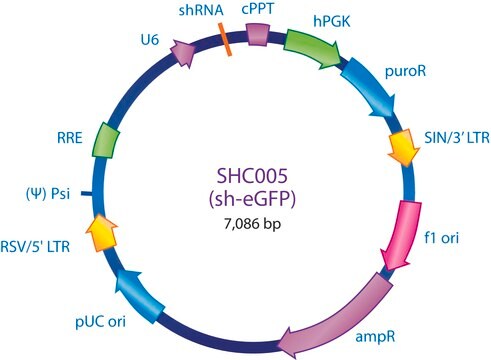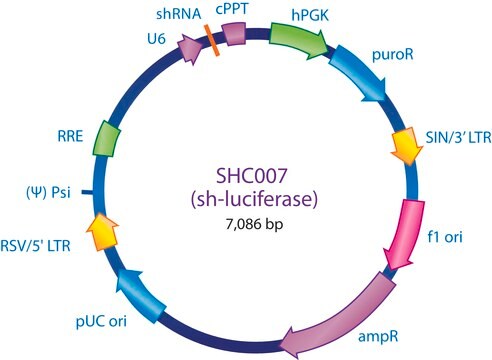Recommended Products
General description
Sigma shRNA Human Kinase Pooled Lentiviral Library
Sigma-Aldrich has a long-standing expertise in pooled lentiviral screening spanning whole genome and custom pool offerings. Due to the popular demand of the kinase gene panel, we are proud to offer an off-the-shelf, ready-to-use shRNA kinase pool optimized to meet researchers′ needs. This pooled library targets the human kinome, a collection of approximately 745 genes commonly associated with development and disease, with an average of 12.6 shRNA clones per unique kinase gene. More importantly, this shRNA pool contains important enrichment, depletion, and non-target controls so you can be confident in your results, and reduce the likelihood of false positives or negatives. The lentiviral format allows for stable integration, selection, and enrichment of transduced cells, allowing researchers to functionally screen hundreds of kinase genes for a fraction of the time and cost of screening arrayed clones.
Whether you are interested in small molecule screening or in defining developmental signaling pathways, Sigma′s shRNA human kinase pooled lentiviral library offers researchers a high throughput solution to uncover novel kinase targets, especially when essential and lethal genes are important.
Differences "between hit genes called by CRISPRi and RNAi are not necessarily an indication of technical shortcomings of either method, but can also guide new biological discoveries. The difference [lies] in the mode of action of CRISPRi and RNAi: Whereas CRISPRi targets entire transcription units, including alternative splice isoforms and embedded ncRNAs, RNAi targets mature transcripts and thus differentiates between different products processed from the same primary transcript. Parallel CRISPRi and RNAi screens can reveal novel transcript functions in cases where CRISPRi and RNAi phenotypes for reagents designed to target the same gene product differ." From Kampmann et. al. PNAS (2014) 112(26): June, 2015.
Please also see our Human Kinase Lentiviral CRISPR Pool for more information on how to complement your RNAi screen(s).
Sigma-Aldrich has a long-standing expertise in pooled lentiviral screening spanning whole genome and custom pool offerings. Due to the popular demand of the kinase gene panel, we are proud to offer an off-the-shelf, ready-to-use shRNA kinase pool optimized to meet researchers′ needs. This pooled library targets the human kinome, a collection of approximately 745 genes commonly associated with development and disease, with an average of 12.6 shRNA clones per unique kinase gene. More importantly, this shRNA pool contains important enrichment, depletion, and non-target controls so you can be confident in your results, and reduce the likelihood of false positives or negatives. The lentiviral format allows for stable integration, selection, and enrichment of transduced cells, allowing researchers to functionally screen hundreds of kinase genes for a fraction of the time and cost of screening arrayed clones.
Whether you are interested in small molecule screening or in defining developmental signaling pathways, Sigma′s shRNA human kinase pooled lentiviral library offers researchers a high throughput solution to uncover novel kinase targets, especially when essential and lethal genes are important.
Differences "between hit genes called by CRISPRi and RNAi are not necessarily an indication of technical shortcomings of either method, but can also guide new biological discoveries. The difference [lies] in the mode of action of CRISPRi and RNAi: Whereas CRISPRi targets entire transcription units, including alternative splice isoforms and embedded ncRNAs, RNAi targets mature transcripts and thus differentiates between different products processed from the same primary transcript. Parallel CRISPRi and RNAi screens can reveal novel transcript functions in cases where CRISPRi and RNAi phenotypes for reagents designed to target the same gene product differ." From Kampmann et. al. PNAS (2014) 112(26): June, 2015.
Please also see our Human Kinase Lentiviral CRISPR Pool for more information on how to complement your RNAi screen(s).
Application
Functional Genomics/Screening/Target Validation
Features and Benefits
Knockdown Human Kinases using Sigma shRNA Pooled Lentivirus
Protein kinases are among the largest and most well studied gene families. Protein phosphorylation plays an essential role in intercellular communication in eukaryotic organisms by mediating signal transduction during development, transcription, immune response, metabolism, apoptosis, and cell differentiation. Aberrant regulation of kinases plays a causal role in many diseases, and the study of these proteins and their functions will contribute to the discovery and development of new therapeutics.
The Sigma shRNA Human Kinase Lentiviral Pooled Library contains:
Protein kinases are among the largest and most well studied gene families. Protein phosphorylation plays an essential role in intercellular communication in eukaryotic organisms by mediating signal transduction during development, transcription, immune response, metabolism, apoptosis, and cell differentiation. Aberrant regulation of kinases plays a causal role in many diseases, and the study of these proteins and their functions will contribute to the discovery and development of new therapeutics.
The Sigma shRNA Human Kinase Lentiviral Pooled Library contains:
- Over 9,400+ lentiviral shRNA clones to knockdown over 745 human kinase genes
- High clone coverage (average of 12.6 per gene) increases the statistical strength of your hit analysis
- Numerous built-in enrichment and depletion clones allow researchers to confidently gauge the success of their pooled screening experiments (enrichment controls: PTEN and NF1. Depletion controls: ANAPC2, ANAPC4, and ESR1).
- The pool contains over 50 non-targeting control shRNAs as normalization standards (including GFP, RFP, LacZ, luciferase, and scrambled controls)
Components
The lentiviral human shRNA kinase pool is provided as 100 μl in 4 x 25 μl aliquots at a minimum titer of 5x108 viral particles/ml.
Principle
Sigma Lentiviral shRNAs
Lentiviral-based particles permit efficient transduction and integration of the expression cassette into differentiated and non-dividing cells, such as neurons and dendritic cells. Self-inactivating replication incompetent lentiviral particles are generated in producer cells (HEK 293T) by co-transfection with compatible packaging plasmids. In addition, the lentiviral transduction particles are pseudotyped with an envelope G glycoprotein from Vesicular Stomatitis Virus (VSV-G), allowing transduction of a wide variety of mammalian cells.
Lentiviral-based particles permit efficient transduction and integration of the expression cassette into differentiated and non-dividing cells, such as neurons and dendritic cells. Self-inactivating replication incompetent lentiviral particles are generated in producer cells (HEK 293T) by co-transfection with compatible packaging plasmids. In addition, the lentiviral transduction particles are pseudotyped with an envelope G glycoprotein from Vesicular Stomatitis Virus (VSV-G), allowing transduction of a wide variety of mammalian cells.
Other Notes
This product is for R&D use only, not for drug, household, or other uses. Please consult the Safety Data Sheet for information regarding hazards and safe handling practices. Though the lentiviral transduction particles produced are replication incompetent, it is recommended that they be treated as Risk Group Level 2 (RGL-2) organisms in laboratory handling. Follow all published RGL-2 guidelines for laboratory handling and waste decontamination.
Legal Information
MISSION is a registered trademark of Merck KGaA, Darmstadt, Germany
Storage Class Code
12 - Non Combustible Liquids
WGK
WGK 3
Flash Point(F)
Not applicable
Flash Point(C)
Not applicable
Certificates of Analysis (COA)
Search for Certificates of Analysis (COA) by entering the products Lot/Batch Number. Lot and Batch Numbers can be found on a product’s label following the words ‘Lot’ or ‘Batch’.
Already Own This Product?
Find documentation for the products that you have recently purchased in the Document Library.
Customers Also Viewed
Ophir Shalem et al.
Science (New York, N.Y.), 343(6166), 84-87 (2013-12-18)
The simplicity of programming the CRISPR (clustered regularly interspaced short palindromic repeats)-associated nuclease Cas9 to modify specific genomic loci suggests a new way to interrogate gene function on a genome-wide scale. We show that lentiviral delivery of a genome-scale CRISPR-Cas9
Profiling Essential Genes in Human Mammary Cells by Multiplex RNAi Screening
Silva, J. et al.
Science, 319, 617-620 (2008)
Ana M Mendes-Pereira et al.
Proceedings of the National Academy of Sciences of the United States of America, 109(8), 2730-2735 (2011-04-13)
Therapies that target estrogen signaling have made a very considerable contribution to reducing mortality from breast cancer. However, resistance to tamoxifen remains a major clinical problem. Here we have used a genome-wide functional profiling approach to identify multiple genes that
Our team of scientists has experience in all areas of research including Life Science, Material Science, Chemical Synthesis, Chromatography, Analytical and many others.
Contact Technical Service










